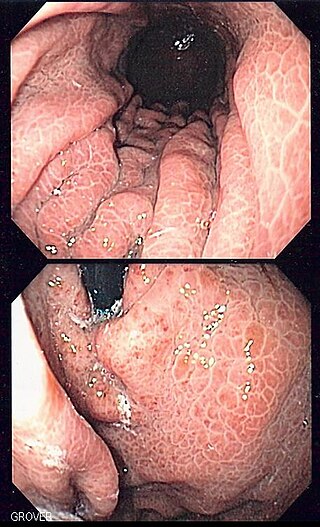Other uses
The Spontaneous Hypertensive Rat is also a model for anxiety.[ citation needed ] Extracellular ATP is a mediator of arterial wall hyperplasia and hypertrophy in this model, as notably demonstrated by Jacobson et al 2006 and Kolosova et al 2005 - a regulator of vascular permeability, by the same - and controls smooth muscle cell and blood cell (including monocyte) migration and proliferation, demonstrated in Gerasimovskaya et al 2002, Satterwhite et al 1999, Kaczmarek et al 2005, Lemoli et al 2004, and Rossi et al 2007. [16]
See also
Related Research Articles

Attention deficit hyperactivity disorder (ADHD) is a neurodevelopmental disorder characterised by executive dysfunction occasioning symptoms of inattention, hyperactivity, impulsivity and emotional dysregulation that are excessive and pervasive, impairing in multiple contexts, and otherwise age-inappropriate.

Hypertension, also known as high blood pressure, is a long-term medical condition in which the blood pressure in the arteries is persistently elevated. High blood pressure usually does not cause symptoms. It is, however, a major risk factor for stroke, coronary artery disease, heart failure, atrial fibrillation, peripheral arterial disease, vision loss, chronic kidney disease, and dementia. Hypertension is a major cause of premature death worldwide.

Clonidine, sold under the brand name Catapres among others, is an α2-adrenergic agonist medication used to treat high blood pressure, ADHD, drug withdrawal, menopausal flushing, diarrhea, spasticity, and certain pain conditions. It is used orally, by injection, or as a transdermal skin patch. Onset of action is typically within an hour with the effects on blood pressure lasting for up to eight hours.

Atomoxetine, sold under the brand name Strattera, is a medication used to treat attention deficit hyperactivity disorder (ADHD). It may be used alone or along with psychostimulants. It is also used as a cognitive and executive functioning enhancer to improve self-motivation, persistence, attention, inhibition, and working memory. Use of atomoxetine is only recommended for those who are at least six years old. It is taken orally. Atomoxetine is a selective norepinephrine reuptake inhibitor and is believed to work by increasing norepinephrine and dopamine levels in the brain.
Adult attention deficit hyperactivity disorder is the neurological condition of attention deficit hyperactivity disorder (ADHD) in adults. About one-third to two-thirds of children with symptoms from early childhood continue to demonstrate ADHD symptoms throughout life.

Policosanol is the generic term for a mixture of long chain alcohols extracted from plant waxes. It is used as a dietary supplement.

Laboratory rats or lab rats are strains of the subspecies Rattus norvegicus domestica which are bred and kept for scientific research. While less commonly used for research than laboratory mice, rats have served as an important animal model for research in psychology and biomedical science.

A hypertensive emergency is very high blood pressure with potentially life-threatening symptoms and signs of acute damage to one or more organ systems. It is different from a hypertensive urgency by this additional evidence for impending irreversible hypertension-mediated organ damage (HMOD). Blood pressure is often above 200/120 mmHg, however there are no universally accepted cutoff values. Signs of organ damage are discussed below.
Severely elevated blood pressure is referred to as a hypertensive crisis, as blood pressure at this level confers a high risk of complications. People with blood pressures in this range may have no symptoms, but are more likely to report headaches and dizziness than the general population. Other symptoms accompanying a hypertensive crisis may include visual deterioration due to retinopathy, breathlessness due to heart failure, or a general feeling of malaise due to kidney failure. Most people with a hypertensive crisis are known to have elevated blood pressure, but additional triggers may have led to a sudden rise.
Hypertensive encephalopathy (HE) is general brain dysfunction due to significantly high blood pressure. Symptoms may include headache, vomiting, trouble with balance, and confusion. Onset is generally sudden. Complications can include seizures, posterior reversible encephalopathy syndrome, and bleeding in the back of the eye.
Attention deficit hyperactivity disorder management options are evidence-based practices with established treatment efficacy for ADHD.

Portal hypertensive gastropathy refers to changes in the mucosa of the stomach in patients with portal hypertension; by far the most common cause of this is cirrhosis of the liver. These changes in the mucosa include friability of the mucosa and the presence of ectatic blood vessels at the surface. Patients with portal hypertensive gastropathy may experience bleeding from the stomach, which may uncommonly manifest itself in vomiting blood or melena; however, portal hypertension may cause several other more common sources of upper gastrointestinal bleeding, such as esophageal varices and gastric varices. On endoscopic evaluation of the stomach, this condition shows a characteristic mosaic or "snake-skin" appearance to the mucosa of the stomach.

Thyroid hormone-inducible hepatic protein is a protein that in humans is encoded by the THRSP gene.

Pathophysiology is a study which explains the function of the body as it relates to diseases and conditions. The pathophysiology of hypertension is an area which attempts to explain mechanistically the causes of hypertension, which is a chronic disease characterized by elevation of blood pressure. Hypertension can be classified by cause as either essential or secondary. About 90–95% of hypertension is essential hypertension. Some authorities define essential hypertension as that which has no known explanation, while others define its cause as being due to overconsumption of sodium and underconsumption of potassium. Secondary hypertension indicates that the hypertension is a result of a specific underlying condition with a well-known mechanism, such as chronic kidney disease, narrowing of the aorta or kidney arteries, or endocrine disorders such as excess aldosterone, cortisol, or catecholamines. Persistent hypertension is a major risk factor for hypertensive heart disease, coronary artery disease, stroke, aortic aneurysm, peripheral artery disease, and chronic kidney disease.

Complications of hypertension are clinical outcomes that result from persistent elevation of blood pressure. Hypertension is a risk factor for all clinical manifestations of atherosclerosis since it is a risk factor for atherosclerosis itself. It is an independent predisposing factor for heart failure, coronary artery disease, stroke, kidney disease, and peripheral arterial disease. It is the most important risk factor for cardiovascular morbidity and mortality, in industrialized countries.

Terje Sagvolden was a Norwegian behavioral neuroscientist, a professor at the Universities of Oslo and Tromsø, and adjunct professor at the University of Maryland, Baltimore County.

Metadoxine, also known as pyridoxine-pyrrolidone carboxylate, is a drug used to treat chronic and acute alcohol intoxication. Metadoxine accelerates alcohol clearance from the blood.

Piromelatine (Neu-P11) is a multimodal sleep drug under development by Neurim Pharmaceuticals. It is an agonist at melatonin MT1/MT2 and serotonin 5-HT1A/5-HT1D receptors. Neurim is conducting a phase II randomized, placebo controlled trial of cognitive and sleep effects in Alzheimer's disease.

20-Hydroxyeicosatetraenoic acid, also known as 20-HETE or 20-hydroxy-5Z,8Z,11Z,14Z-eicosatetraenoic acid, is an eicosanoid metabolite of arachidonic acid that has a wide range of effects on the vascular system including the regulation of vascular tone, blood flow to specific organs, sodium and fluid transport in the kidney, and vascular pathway remodeling. These vascular and kidney effects of 20-HETE have been shown to be responsible for regulating blood pressure and blood flow to specific organs in rodents; genetic and preclinical studies suggest that 20-HETE may similarly regulate blood pressure and contribute to the development of stroke and heart attacks. Additionally the loss of its production appears to be one cause of the human neurological disease, Hereditary spastic paraplegia. Preclinical studies also suggest that the overproduction of 20-HETE may contribute to the progression of certain human cancers, particularly those of the breast.
Selective norepinephrine reuptake inhibitors (sNRIs) are a class of drugs that have been marketed as antidepressants and are used for various mental disorders, mainly depression and attention-deficit hyperactivity disorder (ADHD). The norepinephrine transporter (NET) serves as the fundamental mechanism for the inactivation of noradrenergic signaling because of the NET termination in the reuptake of norepinephrine (NE). The selectivity and mechanism of action for the NRI drugs remain mostly unresolved and, to date, only a limited number of NRI-selective inhibitors are available. The first commercially available selective NRI was the drug reboxetine (Edronax), developed as a first-line therapy for major depressive disorder. Atomoxetine (Strattera) is another potent and selective NRI which is also effective and well tolerated for the treatment of ADHD in adults; it may also be a new treatment option for adults with ADHD, particularly for those patients at risk of substance abuse.
References
- ↑ Pinto YM, Paul M, Ganten D (July 1998). "Lessons from rat models of hypertension: from Goldblatt to genetic engineering". Cardiovascular Research. 39 (1): 77–88. doi: 10.1016/S0008-6363(98)00077-7 . PMID 9764191.
- ↑ Okamoto K, Aoki K (March 1963). "Development of a strain of spontaneously hypertensive rats". Japanese Circulation Journal. 27 (3): 282–93. doi: 10.1253/jcj.27.282 . PMID 13939773.
- ↑ Conrad CH, Brooks WW, Hayes JA, Sen S, Robinson KG, Bing OH (January 1995). "Myocardial fibrosis and stiffness with hypertrophy and heart failure in the spontaneously hypertensive rat". Circulation. 91 (1): 161–70. doi:10.1161/01.cir.91.1.161. PMID 7805198.
- ↑ Kawabe K, Watanabe TX, Shiono K, Sokabe H (November 1978). "Influence on blood pressure of renal isografts between spontaneously hypertensive and normotensive rats, utilizing the F1 hybrids". Japanese Heart Journal. 19 (6): 886–94. doi: 10.1536/ihj.19.886 . PMID 374777.
- ↑ Rettig R (April 1993). "Does the kidney play a role in the aetiology of primary hypertension? Evidence from renal transplantation studies in rats and humans". Journal of Human Hypertension. 7 (2): 177–80. PMID 8510091.
- ↑ Churchill PC, Churchill MC, Griffin KA, et al. (May 2002). "Increased genetic susceptibility to renal damage in the stroke-prone spontaneously hypertensive rat". Kidney International. 61 (5): 1794–800. doi: 10.1046/j.1523-1755.2002.00321.x . PMID 11967029.
- ↑ http://www.emrgnc.com.au/apithology.htm%5B%5D
- ↑ Sagvolden T, Johansen EB (2012). "Rat models of ADHD". Behavioral Neuroscience of Attention Deficit Hyperactivity Disorder and Its Treatment. pp. 301–15. doi:10.1007/7854_2011_126. hdl:10642/1175. ISBN 978-3-642-24611-1. PMID 21487952.
{{cite book}}:|journal=ignored (help) - ↑ Sagvolden T, Johansen EB, Wøien G, et al. (December 2009). "The spontaneously hypertensive rat model of ADHD--the importance of selecting the appropriate reference strain". Neuropharmacology. 57 (7–8): 619–26. doi:10.1016/j.neuropharm.2009.08.004. PMC 2783904 . PMID 19698722.
- 1 2 Sagvolden T, Johansen EB, Aase H, Russell VA (June 2005). "A dynamic developmental theory of attention-deficit/hyperactivity disorder (ADHD) predominantly hyperactive/impulsive and combined subtypes". The Behavioral and Brain Sciences. 28 (3): 397–419, discussion 419–68. doi:10.1017/S0140525X05000075. PMID 16209748. S2CID 15649900.
- ↑ Dommett EJ (September 2014). "Using the five-choice serial reaction time task to examine the effects of atomoxetine and methylphenidate in the male spontaneously hypertensive rat". Pharmacology, Biochemistry, and Behavior. 124: 196–203. doi:10.1016/j.pbb.2014.06.001. PMID 24933335. S2CID 23214561.
- ↑ Turner M, Wilding E, Cassidy E, Dommett EJ (April 2013). "Effects of atomoxetine on locomotor activity and impulsivity in the spontaneously hypertensive rat". Behavioural Brain Research. 243: 28–37. doi:10.1016/j.bbr.2012.12.025. PMID 23266523. S2CID 28836973.
- ↑ Brace LR, Kraev I, Rostron CL, Stewart MG, Overton PG, Dommett EJ (September 2015). "Altered visual processing in a rodent model of Attention-Deficit Hyperactivity Disorder" (PDF). Neuroscience. 303: 364–77. doi:10.1016/j.neuroscience.2015.07.003. PMID 26166731. S2CID 38148654.
- ↑ Dommett EJ, Rostron CL (November 2011). "Abnormal air righting behaviour in the spontaneously hypertensive rat model of ADHD". Experimental Brain Research. 215 (1): 45–52. doi:10.1007/s00221-011-2869-7. PMID 21931982. S2CID 18981985.
- ↑ Dommett EJ, Rostron CL (February 2013). "Appetitive and consummative responding for liquid sucrose in the spontaneously hypertensive rat model of attention deficit hyperactivity disorder". Behavioural Brain Research. 238: 232–42. doi:10.1016/j.bbr.2012.10.025. PMID 23117093. S2CID 8087378.
- ↑ Stenmark KR, Yeager ME, El Kasmi KC, Nozik-Grayck E, Gerasimovskaya EV, Li M, et al. (2013-02-10). "The adventitia: essential regulator of vascular wall structure and function". Annual Review of Physiology. Annual Reviews. 75 (1): 23–47. doi:10.1146/annurev-physiol-030212-183802. PMC 3762248 . PMID 23216413.